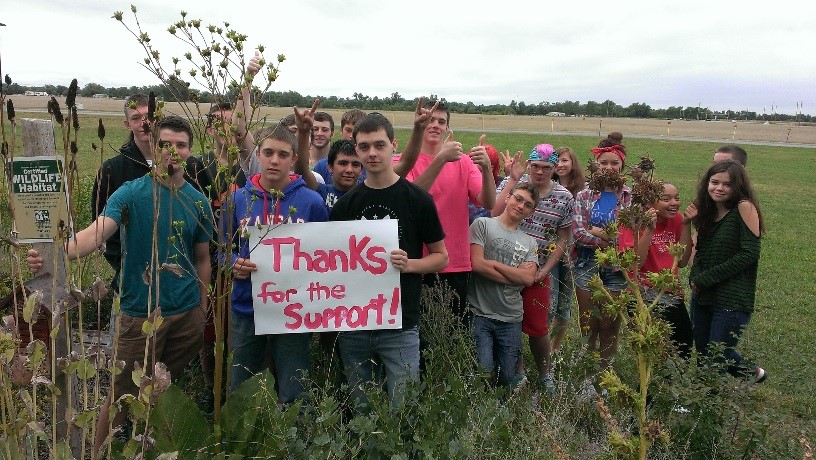We have much more to do and your continued support is needed now more than ever.
Create Habitat in Your Schoolyard Today

To celebrate Earth Day, the National Wildlife Federation is proud to feature Eisenhower High School, a NWF Green Flag school located in Kansas. “Eisenhower High School is a leader and mentor school in the state of Kansas as well as nationwide. We are so proud of the hard work from both the students and educators in their continual learning and educating others about our environment and world!” stated Rachel Wahle from Kansas Association for Conservation & Environmental Education (KACEE).
Eco-Schools USA has partnered with KACEE and Project Learning Tree to nationally recognize schools in Kansas for their achievements in ‘greening’ their schools and integrating environmental education into their curricula. Through this partnership, schools already pursuing recognition through the Kansas Green Schools of Excellence program are also eligible for automatic recognition at the national level through NWF’s Eco-Schools USA and PLT’s GreenSchools program.

Since the school opened in 2011, students and teachers have transformed the barren school grounds into a thriving certified Schoolyard Habitat. Their Eco Code, “To inspire every high school graduate to become environmentally literate citizens making sustainable life choices,” demonstrates why the National Wildlife Federation named them one of America’s Top 10 Eco-Schools in 2015. Through hard work and the help of community partners, Eisenhower High School has created a lasting legacy for both the school and the surrounding community, making the Earth a better place.
Learn how you can implement their ideas in your school today:
Building Schoolyard Habitat

In 2011, a four-phase plan was submitted and approved by the building principal and the USD #265 school board to construct an on-campus Outdoor Wildlife Learning Site (O.W.L.S.). The four phases included:
-

Photo by Denise Scribner, teacher, Eisenhower High School USD #265 Phase I: Establish native plant gardens that will help local pollinators and other wildlife. Eisenhower High School planted 10 elevated interpretive native plant garden beds, growing over 300 culturally significant native plants, wildflowers and grasses. Particular attention was given to planting butterfly milkweed and other pollen-producing plants for migrating pollinators, helping the school gardens become an NWF Certified Wildlife Habitat and certified as a Monarch Way Station by Monarch Watch.
- Phase II: Construct additional conservation measures. To offset the carbon footprint of the school, Eisenhower High School built a 4,000-square-foot native grasses section seeded by the ecology students. They also made a seasonal vernal pond to capture rainwater. Also during Phase II, five additional elevated native flower beds were established and an adjacent river rock Memorial garden with native plantings was constructed. Upcycled benches fashioned from wooden pallets were also constructed by students and added to the site.
- Phase III: Create a way for students and the community to interact with nature. Eisenhower High School designed a QR Nature Trail throughout the O.W.L.S. area with 17 information posts made from recycled plastic with QR coding on the signage. This trail is open to the public to enjoy, allowing the community to connect with nature just as the students do. With the addition of bird houses, brush pile habitats, and other additions, advanced certification of a Bird Friendly Wildlife Habitat was obtained from the National Wildlife Federation for Phase I-III.
-

Aquatics pond. Photo by Denise Scribner, teacher, Eisenhower High School USD #265 Phase IV: Continue with new projects. Along with the native grasses section, Eisenhower High School developed and constructed an aquatics studies pond downstream of the native grasses area. The pond has a clay base and currently holds water year-round, even during extreme drought conditions. During wet seasons, the pond has the potential to be 4.5 feet deep and over 150 yards in diameter. Before street water enters the retention pond, it is partially cleaned and filtered by the native grasses section that it passes through first. Some ecology students even documented the establishment of crayfish in the pond along with raccoons and migratory birds feeding on the crayfish.
Certify TodayIs your school ready to start building habitat? Learn more and certify your schoolyard habitat today!





















